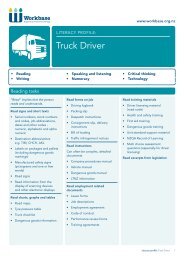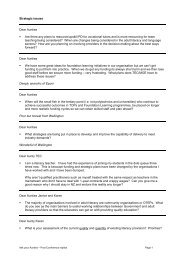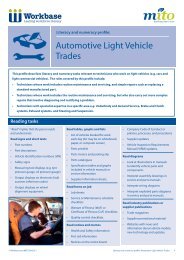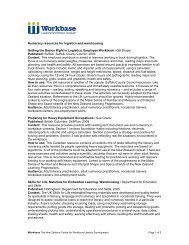A Guide to Workplace Literacy and Numeracy Needs ... - Workbase
A Guide to Workplace Literacy and Numeracy Needs ... - Workbase
A Guide to Workplace Literacy and Numeracy Needs ... - Workbase
Create successful ePaper yourself
Turn your PDF publications into a flip-book with our unique Google optimized e-Paper software.
A <strong>Guide</strong> <strong>to</strong> <strong>Workplace</strong> <strong>Literacy</strong> <strong>and</strong> <strong>Numeracy</strong> <strong>Needs</strong> Analysis 2OverviewA <strong>Guide</strong> <strong>to</strong> <strong>Workplace</strong> <strong>Literacy</strong> <strong>and</strong> <strong>Numeracy</strong> <strong>Needs</strong>Analysis (the <strong>Guide</strong>) has been developed as a resourcefor participants in professional development workshopson workplace literacy needs analysis. This second editionof the <strong>Guide</strong> has been updated <strong>to</strong> reflect changes <strong>to</strong> theworkplace literacy <strong>and</strong> numeracy environment in NewZeal<strong>and</strong> since it was first published in 2006. The TertiaryEducation Strategy 2007-2012 <strong>and</strong> the New Zeal<strong>and</strong> SkillsStrategy Action Plan 2008 both have a priority outcome“increasing the literacy, numeracy <strong>and</strong> language levels ofthe New Zeal<strong>and</strong> workforce”.A detailed rationale for the focus on increasing the literacy<strong>and</strong> numeracy skills of the New Zeal<strong>and</strong> workforce isincluded in the Tertiary Education Commission’s (TEC)<strong>Literacy</strong>, Language <strong>and</strong> <strong>Numeracy</strong> Action Plan 2008-2012.In May this year the New Zeal<strong>and</strong> Government announcedfunding of $168 million for adult literacy for the period2008-2012. A large part of this funding is focused on theNew Zeal<strong>and</strong> workforce. The criteria <strong>and</strong> requirementsfor TEC’s <strong>Workplace</strong> <strong>Literacy</strong> Fund (WLF) have also beenupdated.The remaining five sections directly relate <strong>to</strong> the stagesof a workplace literacy needs analysis.Stage 1 - Planning <strong>and</strong> preparationStage 2 - Organisational analysisStage 3 - Task <strong>and</strong> skill analysisStage 4 - <strong>Literacy</strong> <strong>and</strong> numeracy skills assessmentStage 5 - Analysis <strong>and</strong> reportingCompleting all stages ensures a balanced approach <strong>to</strong>a workplace literacy programme. Dispensing with theorganisational overview <strong>and</strong>/or the task analysis meansthat providers focus only on the employees, <strong>and</strong> issues areseen as skill gaps for employees rather than considering theimpact of organisational fac<strong>to</strong>rs such as company systems<strong>and</strong> processes.An overview of the needs analysis process is set out on thenext page.At the same time the TEC has published the updatedLearning Progressions for Adult <strong>Literacy</strong> <strong>and</strong> <strong>Numeracy</strong>(the Progressions) which are the key framework for adultliteracy <strong>and</strong> numeracy in New Zeal<strong>and</strong>. The Progressionscan, among other things, be used <strong>to</strong> identify the literacy<strong>and</strong> numeracy related dem<strong>and</strong>s of tasks <strong>and</strong> texts <strong>and</strong> thisprocess, called “mapping”, has been incorporated in<strong>to</strong> this<strong>Guide</strong>.The <strong>Guide</strong> starts with an Introduction which situatesa needs analysis in relation <strong>to</strong> the overall process ofestablishing a workplace literacy programme.
Overview A <strong>Guide</strong> <strong>to</strong> <strong>Workplace</strong> <strong>Literacy</strong> <strong>and</strong> <strong>Numeracy</strong> <strong>Needs</strong> Analysis 3An overview of the needs analysis process:Stage1Stage2Stage3Stage4Stage5Planning <strong>and</strong>preparationOrganisationalanalysis<strong>Literacy</strong> task<strong>and</strong> skill analysis<strong>Literacy</strong> <strong>and</strong>numeracy skillsassessmentAnalysis<strong>and</strong> reporting• provider is fundedfor needs analysis• select needsanalysis team• brief team• publicise needsanalysis• site <strong>to</strong>ur• interview:- client liaisonperson- key personnel• observe <strong>and</strong>interviewemployees• collect workplacedocumentation• analyse job role• identify literacytasks• map tasks <strong>and</strong> texts<strong>to</strong> the Progressions<strong>to</strong> identify requiredliteracy <strong>and</strong>numeracy skills• select skills forassessment• developassessment tasks• assess employees• analyse results of:- organisationalanalysis- task <strong>and</strong> skillanalysis- assessments• write report• make presentation<strong>to</strong> client (includingrecommendationsfor programme)
A <strong>Guide</strong> <strong>to</strong> <strong>Workplace</strong> <strong>Literacy</strong> <strong>and</strong> <strong>Numeracy</strong> <strong>Needs</strong> Analysis 4IntroductionThe New Zeal<strong>and</strong> workforceMany employees in the New Zeal<strong>and</strong>workforce do not have all the literacyskills necessary <strong>to</strong> cope with the everydaydem<strong>and</strong>s of work.A survey carried out in 2006 by the New Zeal<strong>and</strong> Ministryof Education, called the Adult <strong>Literacy</strong> <strong>and</strong> Lifeskills Survey(ALLS), showed that 43 per cent of the New Zeal<strong>and</strong>workforce were below the minimum level of literacycompetence for everyday life or work. This survey alsoshowed that 51 per cent of the workforce did not have theminimum level of numeracy competence for everyday life<strong>and</strong> work.Contextual dem<strong>and</strong>s can range from simple <strong>to</strong>complex. Levels of complexity of literacy <strong>and</strong>numeracy at work are linked <strong>to</strong> three main fac<strong>to</strong>rs:• what has <strong>to</strong> be donee.g. the complexity of the task (extent of task <strong>and</strong>knowledge <strong>and</strong> skills required) <strong>and</strong> the complexityof the accompanying text (technical <strong>and</strong> abstractlanguage)• who is doing ite.g. person’s familiarity, knowledge <strong>and</strong> experiencewith context, task <strong>and</strong> text• how much support or assistance is providede.g. amount of expert assistance needed <strong>to</strong>complete task.What is workplace literacy <strong>and</strong> numeracy?<strong>Workplace</strong> literacy <strong>and</strong> numeracy is the reading, writing,speaking <strong>and</strong> listening, <strong>and</strong> numeracy employees in NewZeal<strong>and</strong> workplaces use at work. Employees need <strong>to</strong>read, write, speak <strong>and</strong> listen, calculate, measure <strong>and</strong> usenumbers in a variety of ways that are constantly changing.The variety of ways depends on the job role, the task theemployee is doing, the skills they are using <strong>and</strong> the otherpeople involved.<strong>Literacy</strong> <strong>and</strong> numeracy are social <strong>and</strong> cultural practices thatare fully unders<strong>to</strong>od only in terms of context <strong>and</strong> purpose.Therefore workplace literacy <strong>and</strong> numeracy needs <strong>to</strong> beexamined in terms of settings (where), <strong>and</strong> purposes (why)<strong>and</strong> contextual dem<strong>and</strong>s (what is required).
Introduction A <strong>Guide</strong> <strong>to</strong> <strong>Workplace</strong> <strong>Literacy</strong> <strong>and</strong> <strong>Numeracy</strong> <strong>Needs</strong> Analysis 5Why provide workplace literacy<strong>and</strong> numeracy programmes?<strong>Workplace</strong> literacy <strong>and</strong> numeracy programmes are a directresponse <strong>to</strong> business needs <strong>and</strong> workplace change.These include:• using st<strong>and</strong>ard operating procedures• workplace communication e.g. giving <strong>and</strong> receivinginstructions• new ways of working e.g. team work• technological changes e.g. introduction of computernumerically controlled (CNC) machinery• legislative requirements e.g. health <strong>and</strong> safetylegislation• compliance requirements e.g. export certificates• training e.g. competency based industry training• globalisation.<strong>Workplace</strong> literacy <strong>and</strong> numeracy programmes offer someadvantages over programmes in other settings. Whenworkplace programmes take place on site, during worktime, this overcomes what are often barriers for otherprogrammes, e.g. transport <strong>and</strong> childcare. In additionworkplace programmes use authentic materials from theworkplace which provide learners with opportunities forimmediate practice, as well as making direct connectionsbetween the learning <strong>and</strong> the workplace <strong>and</strong> other contextswhere learners may use these skills.Why do a needs analysis?As part of the criteria for the WLF, the TEC requiresworkplace literacy providers <strong>to</strong> undertake an organisationalneeds analysis <strong>to</strong> inform any later workplace literacy <strong>and</strong>numeracy programme.The key objectives of a needs analysis are <strong>to</strong>:• identify the match between the literacy <strong>and</strong>numeracy skills required by company processes<strong>and</strong> the skills of employees• decide whether or not a programme is necessary• provide a framework for the development <strong>and</strong>evaluation of the programme.The needs analysis process also:• helps <strong>to</strong> publicise the programme <strong>and</strong> enrol linemanagers <strong>and</strong> potential learners• identifies barriers, issues <strong>and</strong> opportunities forany programme• identifies current <strong>and</strong> future literacy <strong>and</strong> numeracytasks <strong>and</strong> skills• identifies whether employees have these skills, <strong>and</strong>• confirms likely benefits for the company, prospectivelearners <strong>and</strong> other stakeholders.Unlike other education programmes the primary focusin workplace programmes is not on the learner. Insteadworkplace literacy programmes have a dual focus, aligningbusiness performance with the development of theindividual employee. This is necessary <strong>to</strong> provide benefitsfor the company (which pays some of the programmecosts), as well as the individuals who participate.
Stage 1 - Planning <strong>and</strong> preparation A <strong>Guide</strong> <strong>to</strong> <strong>Workplace</strong> <strong>Literacy</strong> <strong>and</strong> <strong>Numeracy</strong> <strong>Needs</strong> Analysis 7This <strong>Guide</strong> has as its starting point thatthe workplace literacy provider has beenfunded by TEC <strong>to</strong> carry out an organisationalneeds analysis. As part of the applicationfor funding the provider will have gatheredinformation about the company <strong>to</strong> compilea “profile” of the company <strong>and</strong> its issues.This profile is a reference document for theneeds analysis <strong>and</strong> subsequent programme.Selecting the needs analysis teamThe needs analysis team usually consists of at least twopeople – one of whom has literacy <strong>and</strong> numeracy expertise.The other, whom we refer <strong>to</strong> here as the provider manager,oversees the process, participates in some of it <strong>and</strong> isthe key contact for the client. The literacy <strong>and</strong> numeracyexpert carries out the task <strong>and</strong> skill analysis, develops theassessment tasks <strong>and</strong> leads the assessment of employees.Briefing the needs analysis teamThis is the responsibility of the provider manager.Points <strong>to</strong> cover include:• identify key client personnel – managers,supervisors, union personnel <strong>and</strong> employeeswho will be involved• confirm client liaison person for the needs analysis• confirm site health <strong>and</strong> safety requirements• discuss how client’s staff will be advised – word ofmouth, notices, electronically• confirm whether there is permission <strong>to</strong> takepho<strong>to</strong>graphs on site• possible interview questions• prepare a short presentation or talk for employeesabout the purpose of the needs analysis, timings,activities <strong>and</strong> introducing the provider.Publicise the needs analysisCompany employees need <strong>to</strong> be advised that a needsanalysis is going <strong>to</strong> take place. Work with the company<strong>to</strong> establish the best way <strong>to</strong> do this for their workplace<strong>and</strong> employees. The purpose is <strong>to</strong> inform employees butnot provide so much detail that employees might beconcerned.Carrying out a needs analysis can cause employees <strong>to</strong>feel anxious. This is not surprising considering the needsanalysis involves observing employees working <strong>and</strong> thenlater ‘testing’ their literacy <strong>and</strong> numeracy skills. Employeesare usually keen <strong>to</strong> share what they are doing <strong>and</strong> answerquestions. However there will be some employees who willbe nervous or hostile about aspects of the needs analysis<strong>and</strong> it is important <strong>to</strong> h<strong>and</strong>le that sensitively <strong>and</strong> get theinformation through other means.ProductsAt this stage of the process providers should havethe following documents:• company profile• list of health <strong>and</strong> safety requirements• needs analysis publicity material• permission <strong>to</strong> take pho<strong>to</strong>graphs on site• presentation for employees• list of people <strong>to</strong> be interviewed• list of possible interview questions.
A <strong>Guide</strong> <strong>to</strong> <strong>Workplace</strong> <strong>Literacy</strong> <strong>and</strong> <strong>Numeracy</strong> <strong>Needs</strong> Analysis 8Stage2Stage OneOrganisational analysis
Stage 2 - Organisational analysis A <strong>Guide</strong> <strong>to</strong> <strong>Workplace</strong> <strong>Literacy</strong> <strong>and</strong> <strong>Numeracy</strong> <strong>Needs</strong> Analysis 10Interviewing key personnelGroup Information required MethodManagers • confirm company objectives• confirmation of company profile including key issues, futureplans <strong>and</strong> possible programme goals• communicative processes <strong>and</strong> systems• organisational cultureClient liaison person • site plan• workplace documentation• commentary on information from management1:1interviews/interviewquestions1:1 interviews/interview questionsSupervisorypersonnel• confirm information about the needs analysis already received• processes in their work area• machines/equipment used• range of job roles in their area• information about staff in their work area - shifts, ethnicities,age, qualifications, languages spoken in the workplace, trainingactivities• critical workplace issues• confirmation about documents used in that work area• personal information – role, length of service, qualifications,any issues1:1or group interviews/interview questionsUnion personnel • confirm information already received• information about training <strong>and</strong> skill-based pay systems(e.g. in collective employment agreement or ad hoc)• perceptions about workplace literacy programmes• information about Health <strong>and</strong> Safety Reps <strong>and</strong> Learning Reps• critical workplace issues1:1 interviews/interview questionsKey personnel(could be kaumatuaor matai, team leaders,long-serving employees)Groups of employeesin shifts or teams(this happens occasionally)• confirm information already received• critical workplace issues• need for workplace programme• support for workplace programme• confirm information already received• critical workplace issues• need for workplace programme• support for workplace programme1:1 or groupinterviews/interviewquestionsgroup interviews/interview questions
Stage 2 - Organisational analysis A <strong>Guide</strong> <strong>to</strong> <strong>Workplace</strong> <strong>Literacy</strong> <strong>and</strong> <strong>Numeracy</strong> <strong>Needs</strong> Analysis 12Analysis of documents <strong>and</strong> textsAfter the documents have been collected you need <strong>to</strong> gothrough them with the client liaison person <strong>and</strong> rank themin relation <strong>to</strong> the categories below.• criticality (how important it is <strong>to</strong> the company)• frequency (how often is it used)Category 5 4 3 2 1Criticality Extremely Very Quite Somewhat A littleFrequency Hourly Daily Weekly Monthly Less than monthlyRanking the most critical <strong>and</strong> frequently used documents<strong>and</strong> texts is important when you come <strong>to</strong> decide onassessment tasks in a later stage of the needs analysis.Later you will map the documents <strong>and</strong> oral texts in terms ofcomplexity using the Progressions. For information aboutmapping texts see the Professional Development materialaligned <strong>to</strong> the Learning Progressions at www.tec.govt.nzCompleting the organisational analysisAt the end of this stage providers should be able <strong>to</strong> drawthe company’s workflow as well as describe the company’sprocesses <strong>and</strong> systems, particularly in relation <strong>to</strong> the areasor departments covered by the needs analysis. Providersshould be starting <strong>to</strong> identify whether or not any of thesesystems <strong>and</strong> processes create barriers <strong>and</strong>/or preventemployees accessing company communications.ProductsAt the end of this stage providers will have thefollowing documents:• organisational chart• diagram showing layout of company’s premises• workflow diagram• at least ten of the most critical <strong>and</strong> frequently usedworkplace documents• details of most critical <strong>and</strong> frequently used oral texts.
A <strong>Guide</strong> <strong>to</strong> <strong>Workplace</strong> <strong>Literacy</strong> <strong>and</strong> <strong>Numeracy</strong> <strong>Needs</strong> Analysis 13Stage3Stage OneTask <strong>and</strong> skill analysis
Stage 3 - Task <strong>and</strong> skill analysisA <strong>Guide</strong> <strong>to</strong> <strong>Workplace</strong> <strong>Literacy</strong> <strong>and</strong> <strong>Numeracy</strong> <strong>Needs</strong> Analysis 14Tasks <strong>and</strong> skillsEvery job role involves a number oftechnical job tasks. A task is somethingmeasurable – something that has <strong>to</strong> bedone. To carry out a task a person will use<strong>and</strong> apply a range of skills. These skills canbe acquired throughout our lives.Carrying out a technical task involves the contemporaneouscompletion of literacy <strong>and</strong> numeracy tasks. So when aperson is carrying out a technical task they are also carryingout literacy <strong>and</strong> numeracy tasks. It follows that when theyare using <strong>and</strong> applying technical skills they are also using<strong>and</strong> applying literacy <strong>and</strong> numeracy skills. Here is anexample.Job role – Logyard Opera<strong>to</strong>rJob (technical) tasks• Drive logstacker• Receive (unload) logs from trucks <strong>and</strong> trains<strong>and</strong> place in appropriate bays in logyard• Load logs on<strong>to</strong> slash decks depending onprocessing requirements• Move logs from bay <strong>to</strong> bay depending on logs<strong>to</strong>cks, processing requirements, condition of logs(e.g. green or seasoned)• Participate in logyard <strong>and</strong> wood processing teams<strong>Literacy</strong> <strong>and</strong> numeracy tasks• Carry out pre-start <strong>and</strong> shut down checks onlog stacker• Read logyard signs• Read logyard plan• Read processing plan• Speak <strong>and</strong> listen <strong>to</strong> truck drivers <strong>and</strong> slash deckopera<strong>to</strong>rs using radio-telephone or h<strong>and</strong> signals• Calculate whether load is oversize or not• Measure logs using callipers or tape• Read log markings• Read company procedures• Read <strong>and</strong> respond <strong>to</strong> faxes from managersor suppliers• Read meeting agendas <strong>and</strong> minutes• Complete any necessary forms e.g. reject form• Complete shift log• Contribute at team meetingsA more detailed breakdown of one of these job tasks showing the related literacy <strong>and</strong> numeracy tasks <strong>and</strong> skills is shown on page 15 of this <strong>Guide</strong>.
Stage 3 - Task <strong>and</strong> skill analysis A <strong>Guide</strong> <strong>to</strong> <strong>Workplace</strong> <strong>Literacy</strong> <strong>and</strong> <strong>Numeracy</strong> <strong>Needs</strong> Analysis 17Job Task: Receiving logs in<strong>to</strong> the logyardSpeaking/Listening tasks Reading tasks Writing tasks <strong>Numeracy</strong> tasks• check with driver using radio-telephone• advise driver of any non-compliance(face <strong>to</strong> face)• advise driver where <strong>to</strong> park for unloadingor for checking load• delivery docket from suppliers (email, fax)• SOPs re receipt of logs <strong>and</strong> reject loads fornon-compliance• production details for day (log species,bays etc.)• logyard plan• log markings for correct species• log grade specifications• confirm order received• complete non-compliance documentatione.g. reject form• complete shift log• measure load for height requirementsagainst stanchions (sight)• measure logs for oversize (tape <strong>and</strong> callipers)Speaking/Listening skills Reading skills Writing skills <strong>Numeracy</strong> skills- have a listening <strong>and</strong> speaking vocabulary ofsome general academic <strong>and</strong> specialised words- underst<strong>and</strong> spoken conversations <strong>and</strong> othersimple spoken language- listen for specific information- have an awareness of what <strong>to</strong> do whenlistening comprehension breaks down- have some awareness of purposesfor listening- respond <strong>to</strong> <strong>and</strong> use appropriate language<strong>to</strong> manage simple interactions <strong>and</strong>negotiate meaning- have an awareness of the conventions fortaking part in interactions- take part in spoken conversation <strong>and</strong> usea few oral text types- select <strong>and</strong> communicate information,ideas <strong>and</strong> thoughts using appropriatewords <strong>and</strong> phrases- fluently decode specialised words includingwords of many syllables- moni<strong>to</strong>r reading for accuracy <strong>and</strong> sense- have a reading vocabulary that includes somegeneral academic <strong>and</strong> specialised words- recognise the features <strong>and</strong> structures of arange of text types- be aware of a range of visual text formsthat can be combined with or included inwritten texts- use comprehension strategies <strong>to</strong> assist inunderst<strong>and</strong>ing information or ideas in longeror more complex texts- use strategies <strong>to</strong> locate important informationin texts- have some awareness of the differentpurposes of visual <strong>and</strong> written texts- underst<strong>and</strong> the purpose <strong>and</strong> audiencefor the writing- have a writing vocabulary that is suitablefor the task- have a bank of words that can be writtenau<strong>to</strong>matically <strong>and</strong> accurately- be able <strong>to</strong> use basic grammar <strong>and</strong>punctuation <strong>to</strong> construct short, simplesentences <strong>and</strong> compound sentences- use punctuation effectively- know <strong>and</strong> use the basic features of somecommon text types- write a short comprehensible text usingshort sentences- use knowledge of text structure <strong>to</strong> identify<strong>and</strong> organise a limited number of ideasaround a familiar <strong>to</strong>pic- review <strong>and</strong> then revise writing by making afew simple changes <strong>to</strong> the content based onre-reading <strong>and</strong> feedback- give <strong>and</strong> follow instructions for movementthat involve distance <strong>and</strong> directions- select <strong>and</strong> use appropriate st<strong>and</strong>ard units <strong>and</strong>instruments <strong>to</strong> measure length <strong>and</strong> girth- use common benchmarks <strong>to</strong> selectappropriate methods for estimatingmeasurements- use knowledge of place value, basic addition<strong>and</strong> subtraction facts <strong>and</strong> number sequence- use partitioning strategies <strong>to</strong> solve complexaddition or subtraction problems- use strategies <strong>to</strong> solve problemsthat involve proportions <strong>and</strong> ratios
A <strong>Guide</strong> <strong>to</strong> <strong>Workplace</strong> <strong>Literacy</strong> <strong>and</strong> <strong>Numeracy</strong> <strong>Needs</strong> Analysis 18Stage4Stage One<strong>Literacy</strong> <strong>and</strong> numeracyskills assessment
Stage 5 - Analysis <strong>and</strong> reporting A <strong>Guide</strong> <strong>to</strong> <strong>Workplace</strong> <strong>Literacy</strong> <strong>and</strong> <strong>Numeracy</strong> <strong>Needs</strong> Analysis 25Analyse results of the assessmentsThis can be done in a number of waysbut tables <strong>and</strong> graphs are the most usefulmethod of summarising a lot of information,even if you have only assessed a smallnumber of people. Make sure the tables <strong>and</strong>graphs have clear keys <strong>and</strong> are easy <strong>to</strong> read.Note critical results either before or following therelevant table or graph. For example:• 50% of employees assessed could complete health<strong>and</strong> safety hazard form• 60% of employees assessed could not identifyrelevant information in a table• 70% of employees assessed had good basic mathsknowledge• 50% of employees assessed had low levels of Englishspeaking <strong>and</strong> listening skills, compared with the skillsrequired for their job role.Consider doing analysis by job role, departments or shift(e.g. supervisor/team leader, production/warehouse/dayshift etc). However, be aware of confidentiality issues <strong>and</strong>avoid identifying individuals.Synthesise information from all sourcesIdentify the two or three most critical issues <strong>to</strong> form acontext for this report <strong>and</strong> a background for any futureprogramme. These issues should relate back <strong>to</strong> issues orgoals identified by the company prior <strong>to</strong> the needs analysisbut could also introduce the impact of organisational issuesidentified during the needs analysis e.g. during mapping ofthe company’s systems <strong>and</strong> processes.Write a short description of what the needs analysisshowed in relation <strong>to</strong> critical <strong>and</strong>/or organisational issues<strong>and</strong> how literacy <strong>and</strong> numeracy skill levels are impacting orwill impact on these issues, as well as covering the results ofthe assessments.Here is an example taken from a needs analysis report.“Managers identified that the employee h<strong>and</strong>book <strong>and</strong>St<strong>and</strong>ard Operating Procedures were critical workplace textsthat employees interacted with every day. Managers expectedemployees <strong>to</strong> be able <strong>to</strong> read <strong>and</strong> follow the St<strong>and</strong>ardOperating Procedures <strong>and</strong> report any difficulties with thesedocuments. The employee assessments completed as part ofthe needs analysis found only two of the 18 employees werefamiliar with the employee h<strong>and</strong>book <strong>and</strong> another five saidthey recognised the St<strong>and</strong>ard Operating Procedures. The otheremployees said they had never seen the documents beforeor that other people dealt with them. These results haveimplications in terms of quality cus<strong>to</strong>mer service <strong>and</strong> ongoingcus<strong>to</strong>mer relationships.Reading ability was assessed using questions relating <strong>to</strong> theOSH Alert form, the St<strong>and</strong>ard Operating Procedures <strong>and</strong> theemployee h<strong>and</strong>book. Participants were also asked <strong>to</strong> discussthe cus<strong>to</strong>mer order form. As a result of their answers, needsanalysis participants’ reading skills were rated as low, mediumor high.Four of the 18 participants were rated as having a low readingability. This means they have a limited underst<strong>and</strong>ing ofcritical workplace vocabulary, for example supplier <strong>and</strong>employee. They are not able <strong>to</strong> underst<strong>and</strong> the setting ou<strong>to</strong>f a form using headings <strong>and</strong>, because of this, they cannotlocate information in a document. Their underst<strong>and</strong>ing of allworkplace documentation is extremely limited. One persondid not attempt the reading assessment.
Stage 5 - Analysis <strong>and</strong> reporting A <strong>Guide</strong> <strong>to</strong> <strong>Workplace</strong> <strong>Literacy</strong> <strong>and</strong> <strong>Numeracy</strong> <strong>Needs</strong> Analysis 26Seven of the participants’ reading skills were rated as medium.They have a basic knowledge of most critical workplacevocabulary, although gaps in their vocabulary knowledgeare apparent. For example words such as evacuation <strong>and</strong>hazard were unknown by several of the participants. Theyare able <strong>to</strong> read many words, however comprehension <strong>and</strong>underst<strong>and</strong>ing the entire message is at times limited. Theyare also unable <strong>to</strong> read over a document quickly <strong>and</strong> searchfor key words <strong>to</strong> locate information required. Instead theyhave <strong>to</strong> read the whole document <strong>to</strong> gain the gist. Increasingunderst<strong>and</strong>ing of job-related vocabulary, exp<strong>and</strong>ingfamiliarity with workplace texts <strong>and</strong> developing reading skillswill increase underst<strong>and</strong>ing of workplace procedures <strong>and</strong>support ability <strong>to</strong> manage future changes.Six of the participants were rated as high-level readers. Theyhave an extensive knowledge of workplace vocabulary,can locate information efficiently in known <strong>and</strong> unknowndocuments <strong>and</strong> display an in-depth underst<strong>and</strong>ing of a rangeof workplace documents.”It is important <strong>to</strong> balance the report by recording whatemployees can do as well as what they can not do. Doingthis avoids a punitive or blame culture emerging as a resul<strong>to</strong>f the needs analysis. After all, the purpose of the report is<strong>to</strong> identify skill gaps <strong>and</strong> not label employees as ‘failures’.If you are including in the report information you have beengiven by employees, it is important <strong>to</strong> ensure confidentiality<strong>and</strong> anonymity by stating ‘an employee reported’ or ‘duringdiscussions comments were made about’.RecommendationsMake recommendations for a programme linked <strong>to</strong> theneeds analysis results work group you assessed <strong>and</strong> theissues you have identified.For example, if the skills in one work group, department,or shift are significantly lower than others, you mightrecommend that tuition starts with that group.Alternatively you might recommend starting theprogramme with supervisors or team leaders, as often theirrole in companies is pivotal.Consider recommendations that can be easily implemented<strong>and</strong> that will provide some impact in a relatively short time.Develop strategies for approaching more difficult issues<strong>and</strong> build these in<strong>to</strong> your recommendations.Your reportThe WLF criteria specify that the report from theorganisational needs analysis should outline the literacy<strong>and</strong> numeracy needed in the workplace <strong>and</strong> inform anylater programme. In particular the report needs <strong>to</strong> includeinformation on target groups, the needs of the company<strong>and</strong> current levels of literacy <strong>and</strong> numeracy skills. Theneeds analysis report is needed when Part B of the WLFapplication is submitted. If your report <strong>to</strong> the companycovers the information required by the WLF, you can attachit <strong>to</strong> the application rather than create a separate report.
Stage 5 - Analysis <strong>and</strong> reporting A <strong>Guide</strong> <strong>to</strong> <strong>Workplace</strong> <strong>Literacy</strong> <strong>and</strong> <strong>Numeracy</strong> <strong>Needs</strong> Analysis 27Basic structure of needs analysis report1. Report summarySummarises context, process, key findings <strong>and</strong> recommendations.2. Aim of reportThis very short section describes what you were trying <strong>to</strong> achieve in the needs analysis.3. ProcessAnother short section describes the method used during the needs analysis – what happened, when <strong>and</strong>who was involved.4. ContextTwo or three critical issues which are linked <strong>to</strong> the issues <strong>and</strong>/or goals identified by the client companyprior <strong>to</strong> the needs analysis <strong>and</strong> verified during the process.5. Task analysisThe task analysis for a significant work role could be included in this section.6. Development of assessmentsThis section describes the assessment tasks <strong>and</strong> the rationale for the selection of the skills being assessed.7. Results of the assessmentsThese should be presented by department or role with a summary at the end.8. Recommendations9. Appendices• assessments tasks• graph/tables showing results (if not inserted in the actual report).Presenting your reportYou need <strong>to</strong> send copies of your report <strong>to</strong> the client <strong>and</strong>then personally present your findings of the needs analysis,answer any questions <strong>and</strong> confirm the next steps.Develop a short presentation focussing on key results <strong>and</strong>recommendations. Be prepared <strong>to</strong> add in more detail <strong>and</strong>explanations during the presentation. Often companypersonnel are surprised by the skill levels revealed by theassessments.Ensure you can describe how the identified skilldevelopment needs can be addressed by a workplaceprogramme or other initiatives. Having specific informationabout how improved skills could impact on issues <strong>and</strong>/orgoals identified by the company prior <strong>to</strong> the needs analysisshows the company that you are focussed on improvedperformance.ProductsBy the end of this stage of the process providerswill have the following documents:• analysis of assessments (spreadsheet)• needs analysis report• presentation for company.










